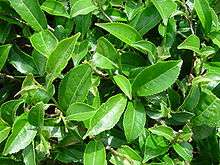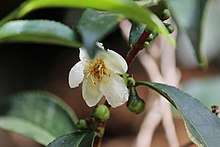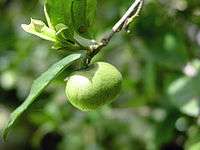Camellia sinensis
Camellia sinensis is a species of evergreen shrubs or small trees in the flowering plant family Theaceae whose leaves and leaf buds are used to produce tea. Common names include "tea plant", "tea shrub", and "tea tree" (not to be confused with Melaleuca alternifolia, the source of tea tree oil, or Leptospermum scoparium, the New Zealand tea tree).
| Camellia sinensis | |
|---|---|
 | |
 | |
| Camellia sinensis foliage | |
| Scientific classification | |
| Kingdom: | Plantae |
| Clade: | Tracheophytes |
| Clade: | Angiosperms |
| Clade: | Eudicots |
| Clade: | Asterids |
| Order: | Ericales |
| Family: | Theaceae |
| Genus: | Camellia |
| Species: | C. sinensis |
| Binomial name | |
| Camellia sinensis (L.) Kuntze | |
| Synonyms[1] | |
| |
C. sinensis var. sinensis and C. s. var. assamica are two major varieties grown today.[2] White tea, yellow tea, green tea, oolong, dark tea (which includes pu-erh tea) and black tea are all harvested from one or the other, but are processed differently to attain varying levels of oxidation. Kukicha (twig tea) is also harvested from C. sinensis, but uses twigs and stems rather than leaves.
Nomenclature and taxonomy
The generic name Camellia is taken from the Latinized name of Rev. Georg Kamel,[3] SJ (1661–1706), a Moravian-born Jesuit lay brother, pharmacist, and missionary to the Philippines.
Carl Linnaeus chose his name in 1753 for the genus to honor Kamel's contributions to botany[4] (although Kamel did not discover or name this plant, or any Camellia,[5] and Linnaeus did not consider this plant a Camellia but a Thea).[6]
Robert Sweet shifted all formerly Thea species to the genus Camellia in 1818.[7] The name sinensis means "from China" in Latin.
Four varieties of C. sinensis are recognized.[1] Of these, C. sinensis var. sinensis and C. s. var. assamica (JW Masters) Kitamura are most commonly used for tea, and C. s. var. pubilimba Hung T. Chang and C. s. var. dehungensis (Hung T. Chang & BH Chen) TL Ming are sometimes used locally.[1] The Cambod type tea (C. assamica subsp. lasiocaly) was originally considered a type of assam tea. However, later genetic work showed that it is a hybrid between Chinese small leaf tea and assam type tea.[8]
Tea plants are native to East Asia, and probably originated in the borderlands of north Burma and southwestern China.[9]
- Chinese (small leaf) tea [C. sinensis var. sinensis]
- Chinese Western Yunnan Assam (large leaf) tea [C. sinensis var. assamica]
- Indian Assam (large leaf) tea [C. sinensis var. assamica]
- Chinese Southern Yunnan Assam (large leaf) tea [C. sinensis var. assamica]
Chinese (small leaf) type tea may have originated in southern China possibly with hybridization of unknown wild tea relatives. However, since no wild populations of this tea are known, the precise location of its origin is speculative.[10][11]
Given their genetic differences forming distinct clades, Chinese Assam type tea (C. s. var. assamica) may have two different parentages – one being found in southern Yunnan (Xishuangbanna, Pu'er City) and the other in western Yunnan (Lincang, Baoshan). Many types of Southern Yunnan Assam tea have been hybridized with the closely related species Camellia taliensis. Unlike Southern Yunnan Assam tea, Western Yunnan Assam tea shares many genetic similarities with Indian Assam type tea (also C. s. var. assamica). Thus, Western Yunnan Assam tea and Indian Assam tea both may have originated from the same parent plant in the area where southwestern China, Indo-Burma, and Tibet meet. However, as the Indian Assam tea shares no haplotypes with Western Yunnan Assam tea, Indian Assam tea is likely to have originated from an independent domestication. Some Indian Assam tea appears to have hybridized with the species Camellia pubicosta.[10][11]
Assuming a generation of 12 years, Chinese small leaf tea is estimated to have diverged from Assam tea around 22,000 years ago, while Chinese Assam tea and Indian Assam tea diverged 2,800 years ago. This divergence tea would correspond to the last glacial maximum.[10][11]
Chinese small leaf type tea was introduced into India in 1836 by the British and some Indian Assam type tea (e.g. Darjeeling tea) appear to be genetic hybrids of Chinese small leaf type tea, native Indian Assam, and possibly also closely related wild tea species.[12]
Cultivars
Hundreds,[13] if not thousands of cultivars of C. sinensis are known. Some Japanese cultivars include:
Description
C. sinensis is native to East Asia, the Indian Subcontinent, and Southeast Asia, but it is today cultivated across the world in tropical and subtropical regions. It is an evergreen shrub or small tree that is usually trimmed to below 2 m (6.6 ft) when cultivated for its leaves. It has a strong taproot. The flowers are yellow-white, 2.5–4 cm (0.98–1.57 in) in diameter, with seven or eight petals.

The seeds of C. sinensis and C. oleifera can be pressed to yield tea oil, a sweetish seasoning and cooking oil that should not be confused with tea tree oil, an essential oil that is used for medical and cosmetic purposes, and originates from the leaves of a different plant.


The leaves are 4–15 cm (1.6–5.9 in) long and 2–5 cm (0.79–1.97 in) broad. Fresh leaves contain about 4% caffeine, as well as related compounds including theobromine.[16] The young, light-green leaves are preferably harvested for tea production; they have short, white hairs on the underside. Older leaves are deeper green. Different leaf ages produce differing tea qualities, since their chemical compositions are different. Usually, the tip (bud) and the first two to three leaves are harvested for processing. This hand picking is repeated every one to two weeks.
In 2017, Chinese scientists sequenced the genome of C. s. var. assamica .[17] It contains about three billion base pairs, which was larger than most plants previously sequenced.[18]
Cultivation
C. sinensis is mainly cultivated in tropical and subtropical climates, in areas with at least 127 cm (50 in) of rainfall a year. Tea plants prefer a rich and moist growing location in full to part sun, and can be grown in hardiness zones 7 – 9. However, the clonal one is commercially cultivated from the equator to as far north as Cornwall and Scotland on the UK mainland.[19][20] Many high quality teas are grown at high elevations, up to 1,500 m (4,900 ft), as the plants grow more slowly and acquire more flavour.
Tea plants will grow into a tree if left undisturbed, but cultivated plants are pruned to waist height for ease of plucking. Two principal varieties are used, the small-leaved Chinese variety plant (C. s. sinensis) and the large-leaved Assamese plant (C. s. assamica), used mainly for black tea.
Chinese teas
The Chinese plant is a small-leafed bush with multiple stems that reaches a height of some 3 m. It is native to southeast China. The first tea plant variety to be discovered, recorded, and used to produce tea dates back 3,000 years ago, it yields some of the most popular teas.
C. s. var. waldenae was considered a different species, C. waldenae by SY Hu,[21] but it was later identified as a variety of C. sinensis.[22] This variety is commonly called Waldenae Camellia. It is seen on Sunset Peak and Tai Mo Shan in Hong Kong. It is also distributed in Guangxi province, China.[21]
Indian and Nepali teas
Three main kinds of tea are produced in India:
- Assam comes from the heavily forested northeastern section of the country, Assam. Tea from here is rich and full-bodied. In Assam, the first tea estate of India was established, in 1837.
- Darjeeling is from the cool and wet Darjeeling region, tucked in the foothills of the Himalayas. Tea plantations reach 2,200 metres. The tea is delicately flavoured, and considered to be one of the finest teas in the world. The Darjeeling plantations have three distinct harvests, termed 'flushes', and the tea produced from each flush has a unique flavour. First (spring) flush teas are light and aromatic, while the second (summer) flush produces tea with a bit more bite. The third, or autumn flush gives a tea that is lesser in quality.
Nepali tea is also considered to be similar to the tea produced in Darjeeling, mostly because the eastern part of Nepal, where a large amount of tea is produced, has similar topography to that of Darjeeling.
- Nilgiri is from a southern region of India almost as high as Darjeeling. Grown at elevations between 1,000 and 2,500 m, Nilgiri teas are subtle and rather gentle, and are frequently blended with other, more robust teas.

Pests and diseases
Tea leaves are eaten by some herbivores, such as the caterpillars of the willow beauty (Peribatodes rhomboidaria), a geometer moth.
Health effects
Although health benefits have been assumed throughout the history of using tea as a common beverage, no high-quality evidence shows that tea confers significant benefits.[23][24] In clinical research over the early 21st century, tea has been studied extensively for its potential to lower the risk of human diseases, but none of this research is conclusive as of 2017.[23]
Biosynthesis of caffeine
Caffeine, a molecule produced in C. sinensis, functions as a secondary metabolite. Caffeine is a purine alkaloid and its biosynthesis occurs in young tea leaves and is regulated by several enzymes.[25][26] The biosynthetic pathway in C. sinensis differs from other caffeine-producing plants such as coffee or guayusa. Analysis of the pathway was carried out by harvesting young leaves and using reverse transcription PCR to analyze the genes encoding the major enzymes involved in synthesizing caffeine. The gene TCS1 encodes caffeine synthase. Younger leaves feature high concentrations of TCS1 transcripts, allowing more caffeine to be synthesized during this time. Dephosphorylation of xanthosine-5'-monophosphate into xanthosine is the committed step for the xanthosines entering the beginning of the most common pathway. A sequence of reactions turns xanthosine into 7-methylxanthosine, then 7-methylxanthine, then theobromine, and finally into caffeine.
See also
- Chinese herbology
- Green tea extract
- International Code of Nomenclature for Cultivated Plants
- ISO 3103, a method of brewing tea according to the ISO
- Kaempferol, a flavanoid found in tea and associated with reduced risk of heart disease
- List of tea companies
- Tasseography, a method of divination by reading tea leaves.
- Tea classics
- Tea production in Sri Lanka
- Turkish tea
- Tea production in Kenya
- Tea leaf grading
- Camellia taliensis
Primary green tea catechins
-Gallocatechin.svg.png) (–)-Epigallocatechin
(–)-Epigallocatechin (–)-Epigallocatechin gallate
(–)-Epigallocatechin gallate (–)-Epicatechin gallate
(–)-Epicatechin gallate-Epicatechin.svg.png) (–)-Epicatechin
(–)-Epicatechin
References
- Min T, Bartholomew B. "18. Theaceae". Flora of China. 12.
- ITIS Standard Report Page Camellia Sinensis retrieved 2009-03-28.
- Stafleu FA, Cowan RS (1976–88). Taxonomic literature: A selective guide to botanical publications and collections with dates, commentaries and types (2nd ed.). Utrecht: Bohn, Scheltema and Holkema.
- "Botanics", History of Tea, 10 August 2003,
Georg Jeoseph Kamel, whose name in Latin was Camellus was missionary to the Philippines, died in Manilla in 1706. […] Camellias were named in posthumous honor of George Joseph Kamel by Carolus Linnæus
. - "Botanics", History of Tea, 10 August 2003,
It is speculated that he never saw a camellia
. - Golender L (10 August 2003), "Botanics", History of Tea,
The first edition of Linnaeus's Species Plantarum published in 1753 suggested calling the tea plant Thea sinensis...
- International Association for Plant Taxonomy (2006), "Article 13, example 3", International Code of Botanical Nomenclature (Vienna Code) (electronic ed.),
The generic names Thea L. (Sp. Pl.: 515. 24 Mai 1753), and Camellia L. (Sp. Pl.: 698. 16 August 1753; Gen. Pl., ed. 5: 311. 1754), are treated as having been published simultaneously on 1 May 1753. … the combined genus bears the name Camellia, since Sweet (Hort. Suburb. Lond.: 157. 1818), who was the first to unite the two genera, chose that name, and cited Thea as a synonym
. - Wambulwa, MC, MK Meegahakumbura, R Chalo, et al. 2016. Nuclear microsatellites reveal the genetic architecture and breeding history of tea germplasm of East Africa. Tree Genetics & Genomes, 12.
- Yamamoto, T; Kim, M; Juneja, L R (1997). Chemistry and Applications of Green Tea. CRC Press. p. 4. ISBN 978-0-8493-4006-2.
For a long time, botanists have asserted the dualism of tea origin from their observations that there exist distinct differences in the morphological characteristics between Assamese varieties and Chinese varieties... Hashimoto and Shimura reported that the differences in the morphological characteristics in tea plants are not necessarily the evidence of the dualism hypothesis from the researches using the statistical cluster analysis method. In recent investigations, it has also been made clear that both varieties have the same chromosome number (n=15) and can be easily hybridised with each other. In addition, various types of intermediate hybrids or spontaneous polyploids of tea plants have been found in a wide area extending over the regions mentioned above. These facts may prove that the place of origin of Camellia sinensis is in the area including the northern part of the Burma, Yunnan, and Sichuan districts of China.
- Meegahakumbura, MK; Wambulwa, MC; Thapa, KK; et al. (2016). "Indications for three independent domestication events for the tea plant (Camellia sinensis (L.) O. Kuntze) and new insights into the origin of tea germplasm in China and India revealed by nuclear microsatellites". PLOS ONE. 11 (5): e0155369. Bibcode:2016PLoSO..1155369M. doi:10.1371/journal.pone.0155369. PMC 4878758. PMID 27218820.
- Meegahakumbura MK, Wambulwa MC, Li MM, et al. (2018). "Domestication origin and breeding history of the tea plant (Camellia sinensis) in China and India based on nuclear microsatellites and cpDNA sequence data". Frontiers in Plant Science. 8: 2270. doi:10.3389/fpls.2017.02270. PMC 5788969. PMID 29422908.
- Wambulwa, MC, MK Meegahakumbura, R Chalo, et al. 2016. Nuclear microsatellites reveal the genetic architecture and breeding history of tea germplasm of East Africa. Tree Genetics & Genomes, 12.
- "Tea Cultivar Database - World of Tea". World of Tea. Retrieved 9 May 2017.
- "Identification of Japanese tea (Camellia sinensis) cultivars using SSR marker". Food and Agriculture Organization. Retrieved 1 November 2018.
- "Varietal differences in the adaptability of tea [Camellia sinensis] cultivars to light nitrogen application". Food and Agriculture Organization. Retrieved 1 November 2018.
- "Camellia sinensis". Purdue. Retrieved 18 February 2008.
- Xia EH, Zhang HB, Sheng J, Li K, Zhang QJ, Kim C, et al. (June 2017). "The Tea Tree Genome Provides Insights into Tea Flavor and Independent Evolution of Caffeine Biosynthesis". Molecular Plant. 10 (6): 866–877. doi:10.1016/j.molp.2017.04.002. PMID 28473262.
- Briggs, Helen (2 May 2017). "Secrets of tea plant revealed by science". BBC News. Retrieved 2 May 2017.
- "Tea", Gardening, Telegraph Online, 17 September 2005.
- "Tea", The world's first Scottish tea, The Independent, 17 November 2014.
- The International Camellia Society (ICS), DE: Uniklinik Sårland, archived from the original on 21 August 2006
- Ming TL (1992). "A revision of Camellia sect. Thea". Acta Botanica Yunnanica (in Chinese). 14 (2): 115–32..
- "Black tea". MedlinePlus, US National Library of Medicine. 30 November 2017. Retrieved 27 February 2018.
- "Green tea". National Center for Complementary and Integrative Health, US National Institutes of Health. 30 November 2016. Retrieved 27 February 2018.
- Li Y, Ogita S, Keya CA, Ashihara H (March 2008). "Expression of caffeine biosynthesis genes in tea (Camellia sinensis)". Zeitschrift für Naturforschung C. 63 (3–4): 267–70. doi:10.1515/znc-2008-3-417. PMID 18533472.
- Kato M, Mizuno K, Fujimura T, Iwama M, Irie M, Crozier A, Ashihara H (June 1999). "Purification and characterization of caffeine synthase from tea leaves". Plant Physiology. 120 (2): 579–86. doi:10.1104/pp.120.2.579. PMC 59297. PMID 10364410.
- Pizzorno JE, Murray MT, eds. (2012). Textbook of Natural Medicine (4th ed.). Edinburgh: Churchill Livingstone. p. 628. ISBN 978-1-4377-2333-5.
External links
| Wikimedia Commons has media related to Camellia sinensis. |
| Wikispecies has information related to Camellia sinensis |
- "Camellia sinensis". Integrated Taxonomic Information System. Retrieved 16 February 2006.
- Camellia sinensis from Purdue University
- The International Camellia Society
- Plant Cultures: botany and history of the tea plant
- Antibacterial Activity of Green Tea Extracts against Streptococcus anginosus group CI.NII.AC.jp
- Jac.OxfordJournals.org, The effect of a component of tea (Camellia sinensis) on methicillin resistance in Staphylococcus.
- Suns.Ars-Grin.gov, List of Chemicals in Camellia sinensis (Dr. Duke's Databases)